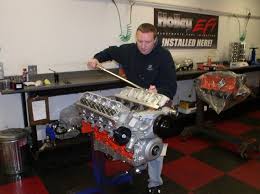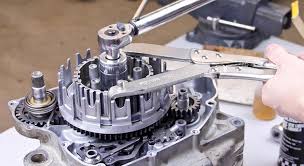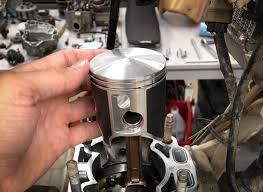What are the most common causes of engine failure?
In most cases, engine failures are caused by one root source: heat. Whether it’s a failure of the cooling system to keep the engine at an optimal operating temperature, or a lack of oil pressure or clean oil to lubricate moving parts which creates excess friction, most major engine failures can be traced back to these events. In general, there are a few specific issues that lead to engine failures including:
- Water pump is broken
- Heater core is clogged
- Thermostat is broken
- Oil pump is damaged
- Oil level is low
- Engine oil is old, too thick, and loses lubricity
When any of these occur, different parts of the engine will become damaged. If the engine overheats, it’s common for head gaskets to fail which introduces coolant inside the engine block within oil galleys. This dilutes the engine oil and causes a lack of lubrication, or excessive heat.
Knowing what caused the engine to fail is the first step in determining whether or not an engine rebuild or replacement is needed.

How Do You Know When You Need an Engine Rebuild?
How Do You Know When You Need an Engine Rebuild? Some of the common problems have already been mentioned. Running issues like an engine misfire, bad oil leaks, engine burning oil, engine head gasket leaks, or your engine pistons slapping inside the cylinders are all reasons your car could need an engine rebuild.
It really comes down to this: a technician has checked out your car, eliminated any other problems as being the cause, and said to you, “You need an engine rebuild.”
You truly need it properly diagnosed because other concerns can make it seem like you need an engine rebuild, even when you don’t. A failed knock sensor can make it seem like your engine’s about to blow up. Low oil level will cause engine knock too. And other timing-related sensors can cause your car not to start. Even electrical problems could mean you need a replacement engine wiring harness, not a whole engine rebuild.
Common Engine Failure Symptoms
Think you might need an engine restore or rebuild? Check out these common symptoms and see if yours matches up:
- The engine knocks and rattles when it’s idling. It’s usually a bottom-end knock caused by worn-out bearings.
- You’re always puffing a thick cloud of smoke from your exhaust. It’s worn-out seals that usually cause your engine to burn oil.
- The timing belt or chain broke. Many engines have interference-style engines that are badly damaged internally when the timing belt breaks.
- It won’t turn over. It could be seized, but you’d better check the battery, the starter motor, and the wiring before an engine rebuild.
- The engine clatters when you’re accelerating. The pistons are moving around in the cylinders too much, and you’ll need an engine rebuild to fix it, even though it runs alright.

Tips For Rebuilding an Engine
In the course of recent weeks I have shed blood, sweat and very nearly a tear or two while attempting to reconstruct the 4G63 engine on my Evo I. It is the first occasion when I’ve at any point endeavored anything like this, and I have taken in one serious parcel. Thought I’d share with you 10 of the things I have found out about rebuilding an engine, basically coming about because of my own failings.
- Have the correct instruments. Can’t pressure this enough. This means having a good quality arrangement of apparatuses to work with. A portion of the things I purchased and truly refreshing were spline attachments to keep screws and nuts from “camming out”, and a breaker bar. Presently on the off chance that you’ve gotten things done on your vehicle as of now you may have these, yet on the off chance that not go out and get a set. This likewise means having the correct devices for the activity. Engine rebuilding takes a couple of expert apparatuses, and while you may have the option to pull off substitutes, you may run into issues (as I did).
- Do your examination. At the point when you modify, work out in the event that you are going for a stock substitution of broken/worn parts, or a full remake utilizing manufactured internals. Work out your budget and attempt to adhere to it. On the off chance that conceivable, get the production line workshop manual for your engine, or a Haynes/Chilton’s manual. Audit it before you get a wrench and make sense of what you will do and how you will do it. Surprises are good at Christmas, yet not when you’re attempting to dismantle an engine. On the off chance that you can’t discover data in there, attempt to locate a regarded source on the web. And ensure you get the CORRECT manual (for example in the event that you have a 7-jolt 4G63 engine don’t utilize a 6-jolt 4G63 engine guide and imagine that everything will be the equivalent. It won’t).
- Get ready for the unexpected. Notwithstanding how well you plan and research, something sooner or later will turn out badly. A jolt will sever, a section you thought was solid will simply self-destruct as it falls off, or things won’t line up when you’re assembling everything back. At the point when it happens attempt to resist the urge to panic and contemplate what has occurred. That can be hard, and I have colossally annoyed at myself, the vehicle, things turning out badly and my moderately absence of mechanical expertise in the course of recent weeks. Be that as it may, perhaps the best thing you can do is return inside, have some tea and consider your concern and what you can do to explain it.
- Anticipate that things should be more terrible than you envision. This goes hand-in-hand with number 3. On the off chance that you think you have harmed a cylinder, expect that when you drop everything out there will be more than 1 cylinder harmed. That way, if the harm is terrible it doesn’t come as a major stun to you, and in the event that it’s not all as awful as you suspected, at that point it’s a decent inspiration and confidence booster.
- Pack them and tag them. Indispensable in the event that you want to spare a great deal of dissatisfaction when assembling things back. Each nut and screw you take off, put in a pack and name it well. Have the same number of packs as you want (I at present have various sacks for certain pulley jolts, fuel injector cuts, for conrod jolts… It causes things so a lot simpler when you to can simply glance through your packs and instantly discover the parts you requirement for the large of the vehicle you’re taking a shot at.

What is the difference between overhaul and rebuild?
With
engines, both auto and aircraft, these terms are used frequently, along with
“reconditioned”.
With aviation, there’s a degree of regulation as to what is being done to an
engine; with cars, be careful what you’re paying for.
A “rebuilt” engine should be put back into like-new condition, with
all parts examined and replaced if they aren’t within new tolerances.
An “overhauled” engine has new parts installed when they are worn
beyond limits, but many are left in place because the wear limit hasn’t been
exceeded.
Technically, an engine can be ‘reconditioned” by simply replacing what’s
broken, without any disassembly beyond the obvious fault…
Facts About Does A New Engine Reset The Odometer
Both the engine and the odometer are two separate entities. The engine helps in running the vehicle while the odometer reflects the distance traveled down the road. Many people believe that when the engine is replaced for one reason or other, the mileage readings would get back to zero. Is it the truth? Let’s find out below.
1. Truth Behind Manipulating The Odometer Readings
An odometer is all about the distance that your vehicle travels since you bought it from a dealer. It is not the engine alone that manipulates the odometer readings. On the contrary, the entire mechanical block does! In simpler words, the odometer signifies the mileage of the whole car and not just the engine.
For instance, one gets a heart donor who is a younger individual. That does not imply that the recipient would turn younger, he would remain the same age. Same is the case with the engine and an odometer. the answer to, “does a new engine reset the odometer,” is no, it So does not reset the odometer.
In case, you opt for manually resetting the odometer; you would have to face legal charges. This is because the engine change status needs to be documented and the mileage change should be calculated and presented. If none of that happens, you would have to bear the dire consequences that follow.
How Can You Reset The Odometer?
As a matter of fact, it is legally not permissible to modify the odometer readings. There are people who before reselling their car think of replacing the engine. Why is that so? This is because of the misconception that the engine replacement would reset the odometer ratings that, in turn, would bring good value for the car. You need to realize that this is a mere fallacy.
It may surprise you, but if you wish to reset the odometer, you would have to go an extra mile. You would have to rework on the entire car making. Be it replacing the engine, transmission, suspension, brakes, alternator, wiring, or anything you could think of; everything together aids in resetting the odometer. Would you be ready for all of it? Practically speaking, the answer is no! For exploring more on the car related trending topics, refer to maintenance tips.
Wrapping Up
Knowing the facts about “does a new engine reset the odometer,” you would be clear that how odometer readings would never dwindle no matter what. Always remember to follow the standards and never make a decision that could end up ruining things.